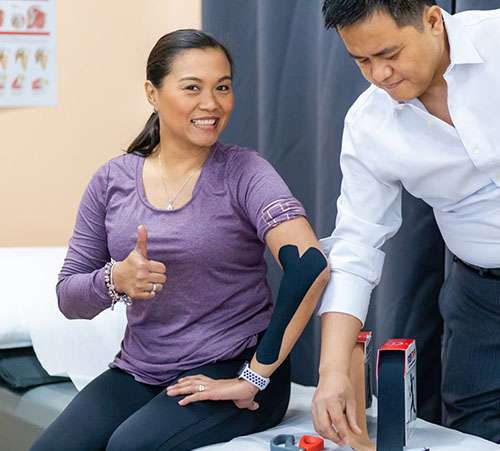Most Common Ankles & Foot Conditions
-
Plantar Fasciitis
Plantar fasciitis is one of the most common causes of heel pain. The fascia connects the heel bone to the toes to supports the arch of the foot when standing. It also absorbs shock and distributes the pressure in the foot.
But when overused, it gets inflamed, resulting in heel pain.
Signs & Symptoms
-
1. Stabbing pain at the bottom of the foot near the heel.
-
2. Increase in pain in the morning.
-
3. Swelling
-
4. Tenderness & stiffness.
-
5. Difficulty in prolonged standing and walking.
The Guide To Recovery
-
1. Reduce inflammation.
-
2. Reduce pressure in the heel by wearing support.
-
3. Stretch tight calf muscles.
-
4. Develop strength and endurance in the foot.
-
5. See a physical therapist.
Heel Spur
Heel Spur is a bony growth under the heel caused by a calcium deposit. It is often caused by strains, repeated irritation of plantar fascia, and heel pressure. Heel spurs are common among athletes whose activities involve running and jumping.
Signs & Symptoms
-
1. Often cause NO symptoms.
-
2. Pain under the heel if tissues are inflamed.
-
3. Difficulty in weight-bearing.
-
4. Increase pain running.
-
5. Presence of a spur in the x-ray.
The Key To Recovery
-
1. Use of shoe inserts to reduce pressure in the spur.
-
2. Taping or splinting.
-
3. Stretch tight calf muscles.
-
4. Improve strength and endurance in foot muscles.
-
5. See a podiatrist or physical therapist.
Achilles Tendinitis
Achilles tendinitis is an inflammation of the tendon at the back of the heel to the lower leg.
It is often caused by repeated stress to the tendon or an injury.
Signs & Symptoms
-
1. Pain and stiffness along the Achilles tendon.
-
2. Pain at the back of the heel that worsens with weight-bearing.
-
3. Tenderness
-
4. Swelling
-
5. Difficulty prolonged standing and walking.
The Key To Recovery
-
1. Reduce inflammation.
-
2. Stretch tight calf muscles.
-
3. Reduce the intensity of activity.
-
4. Splinting or taping.
-
5. Improve strength and endurance without pain.
Morton's Neuroma
Morton’s neuroma is a condition that affects the forefoot, most commonly between the third and fourth toes. It is caused by the thickening of tissues around the nerve.
Signs & Symptoms
-
1. Burning pain at the ball of your foot.
-
2. Numbness in the toes affected.
-
3. Difficulty in weight-bearing function.
The Key To Recovery
-
1. Changes in footwear to decrease pressure on the ball of the foot.
-
2. Use of shoe inserts to reduce irritation.
-
3. Prescribed medications.
-
4. See a podiatrist and a physical therapist.
Metatarsalgia
Metatarsalgia refers to the inflammation at the ball of the foot. It is located around the arch to the toes. It is caused by repeated stress or excessive pressure at the ball of the foot.
Signs & Symptoms
-
. Pain at the end of the metatarsal bone.
-
. Increase in symptoms with prolonged weight-bearing.
-
. Difficulty walking.
-
. High heel walking increases symptoms.
The Key To Recovery
-
. Reduce inflammation.
-
. Use of shoe insert, splint, or taping.
-
. Wear proper shoes.
-
. Reduce stress in the ball of the foot.
-
. Strengthen targeted foot muscles.
-
-
Protective
CareOur approach to care is to protect your injury or surgery. We focus on stopping more damage to your tissues and start the healing process.The ideal method of care when you can't function due to pain and weakness. You still depend on others fully to meet your needs.Our treatment is to protect, rest, ice, compress, and elevate the injured tissue with your prescribed medications. We will also teach you home remedies.Our goal is to kick-start your recovery and prevent secondary problems. We want you to heal at the expected time.
-
-
-
Gentle
CareOur approach to care is gradual when your condition is stable but painful. Then, we focus on faster healing of your tissues and recovery of function.The ideal method when your pain is bearable, but the movement is limited. Besides, you show difficulty performing self-care and daily routine.Our treatment is heat or cold, ultrasound, and TENS combined with massages. You will start with pain-free exercises to improve your functions.Our goal is to accomplish your daily needs with no assistance. We will prepare you to regain your primary activities.
-
-
-
Progressive
CareOur approach to care is aggressive when you need to regain normal function. Our focus is training related to your daily work and active life.The choice of care when performing your daily duties is still challenging. You still have an increase in pain with increasing activities.Our treatment includes manual therapy to deal with spasms and tightness. Then, we prescribe exercises and targeted work-outs to a balanced posture.Our goal is for you to perform daily duties and hobbies without pain. Moreover, we will guide you to improve your strength without difficulty.
-
-
-
Enhance
CareOur approach to care is to maximize your performance in sports. Therefore, we focus on specific training to boost your skills in a game.The perfect method when you need to optimize your skills. It will be best to refine your balance, agility, and posture to perform better in sports.Our treatment includes taping and manual therapy to activate muscle action. In addition, you practice targeted training for specific game skills.Our goal is for you to perform well in sports and enjoy your hobbies. Thus, we will help maximize your performance in your game.
-

Physical Therapy Method of Care
Our treatment is based on the proven method of physical therapy. We use techniques tested to help our patients recover and live pain-free.
For more than 20 years of experience, the methods and healing process is almost the same for each patient. But our approach depends on their issues. Besides, we treat patients as a human, not a body part.
Our best experience for recovery is to give proper care. We have to feel what our patients feel and understand their concerns. Only then we provide the best care.
At CT Physical Therapy Care, our happiness is to give you a 5 Start experience!

Contact Us
-


